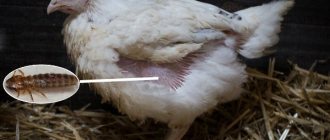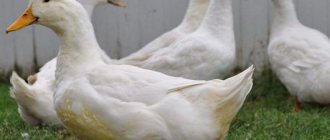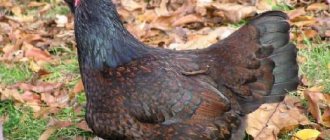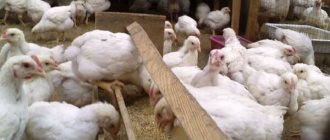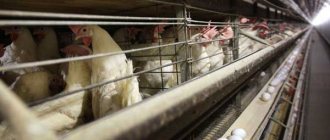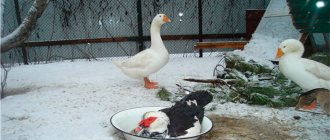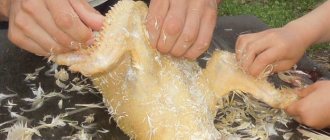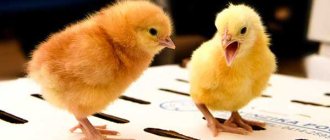1 681
no comments yet
1
Author of the article
Sadchikov Nikolay Alekseevich
Reading time: 3 minutes
Type of medicine: acaricide, insecticide (active ingredient - sulfur).
Release form: smoke bomb, powder.
Purpose:: chicken mites, down-eaters.
Analogues of the drug: permethrin, pawn-B, ectomethrin CE.
Cost of the drug: from 30 to 150 rubles per package (8 pcs).
Sulfur dioxide, released when a bomb is burned, has an antiparasitic effect. Kills scabies mites, fleas, lice. Highly toxic. Effect on parasites:
- suppression of the respiratory system, cessation of gas exchange;
- metabolic disorder;
- paralysis due to damage to the nervous system.
Chicken mites
A sign that the chicken population is affected by mites is the reluctance of the birds to return to the chicken coop: these arthropods are most active at night, causing significant discomfort to the chickens. Soon external signs appear: discoloration of the scallop, cough, constant shaking of the head, egg production decreases, and brown spots appear on the eggs.
Treating a disease is much more difficult than preventing it. The most effective method of prevention is periodic treatment of the chicken coop from parasites: just a few hours - and the destruction of ticks and other parasitic insects is guaranteed.
Fleas are down and feather eaters
Unlike ticks, fleas live on the surface of the skin and feed on dead particles of the epithelium and, as the name suggests, down and feathers. Diagnosis is not difficult: insects are up to 2 mm in size and visible to the naked eye. Chickens behave very restlessly: they pull out feathers and constantly roll around in the sand or dust. Treating your chicken coop for fleas using special products is the only reliable way to prevent infestation.
Even though fleas live on the surface of the skin, they have a significant impact on the overall physical condition of chickens. Birds fly less, lose weight, and go bald. Treatment is quite expensive and lengthy. Don't want extra costs? Don’t wait until the first symptoms of infection appear: just carry out preventive treatment of the chicken coop against fleas!
Checkers for processing the chicken coop
Folk remedies for combating chicken parasites often do not bring the desired results. Potato or carrot tops do repel pests, but it would take a whole field of vegetables to cover the entire floor to be effective enough. The use of modern chemicals is much more effective: in particular, sulfur in combination with α-cypermethrin is guaranteed to destroy all parasites - fleas, ticks, lice, flies, both adults and their eggs and larvae.
The most effective means of treating a chicken coop is fumigation. When washing and spraying, many surfaces remain untreated, and the mist of sulfur and α-cypermethrin easily penetrates hard-to-reach places, destroying the parasites accumulated there. Treating the chicken coop with a sulfur bomb guarantees the destruction of mold, mildew and other dangerous microorganisms.
Treatment of chicken coops with a checker PESHKA-V
The process of fumigating a chicken coop is not difficult: you can start working immediately after reading the instructions. It is clear that there should be no birds in the room during processing. It is also necessary to remove any remaining food, drinking water, and equipment. “PESHKA-B” checkers are evenly distributed over the entire area of the room and set on fire. Thanks to the special pyrotechnic composition, the active substances do not burn, but sublimate. The resulting fine smoke quickly fills the internal space, penetrating into hard-to-reach places. Three to four hours is enough for all insects and harmful microorganisms to be destroyed. After exposure, the chicken coop is thoroughly ventilated for several hours, after which the birds can be released into it.
If you need additional information on checkers for treating a chicken coop against insects, contact the consultant managers of MK PERI: they know the answers to all your questions!
Checker PAWN-B
The PESHKA-V checker is used to destroy ectoparasites, animals and birds, plant pests and supplies in livestock buildings, poultry buildings, greenhouses, granaries, elevators and mills, vegetable storehouses, fruit storehouses and warehouses.
Net weight of the checker is 500 g, D.V. - 450 g/kg cypermethrin Packaging - boxes (20 pieces, 120 pieces) Registered in the Ministry of Agriculture of the Russian Federation - Registration No. PVR-5-7.6/01909 dated 04/03/07.
Harmful objects 1 checker per room volume (m 3):
Livestock premises: Flies 1000-1200; Lice eaters, lice 500-700; Gadflies, scabies, midges 200-400
Poultry premises: Flies 1000-1200; Persian and gamas ticks, down ticks, feather eaters 500-700; Bed bug 200-400
Greenhouses, warehouses, granaries, vegetable stores: Pest complex of stocks 200-400
ATTENTION! Sending of goods (checkers) is carried out on the basis of full prepayment, only for legal entities and individual entrepreneurs!
Minimum quantity: 1 box (20 pieces).
One of the factors influencing the improvement of the quality and quantity of meat and eggs is compliance with sanitary and hygienic conditions in the poultry house.
For this purpose, the chicken coop should be disinfected regularly. It includes wet cleaning and treating the room with various preparations.
Reasons for disinfection
When keeping poultry, a lot of waste is generated (chicken droppings, leftover feed, feathers), which are susceptible to rotting and provide a favorable environment for the life, reproduction and nutrition of various microorganisms.
Without regular cleaning, poultry become susceptible to diseases and epidemics , which can cause serious damage to the household.
A sick broiler loses weight, and the meat loses its presentation and becomes unsafe for consumption. Sick laying hens lay fewer eggs and may be infected with an infection such as salmonella.
During epidemics caused by lack of disinfection, the likelihood of death increases. Poultry mortality increases significantly against the background of an increase in the number of parasites in the chicken coop: lice, lice, feather eaters, ticks, trematodes.
To combat harmful microorganisms, it is necessary to regularly disinfect the premises.
Why is disinfection needed?
Disinfection at home is necessary due to the fact that a large number of birds are kept in one, often cramped room. In warm and humid conditions, on bedding, leftover feed and faded feathers, viruses and bacteria multiply quickly, and the likelihood of chicken disease increases. External parasites, fleas and ticks, are also destroyed during treatment.
Disinfection of the premises can be preventive or it can be performed during or after an outbreak of a disease to destroy its pathogens. If this is a therapeutic treatment, then not only the chicken coop is disinfected, but also the walking areas, equipment, etc.
The usual preventive treatment of the chicken coop is carried out before purchasing a large batch of new birds, and also at least 1-2 times (spring and autumn) a year, but more often, for example, 4 times when the season changes.
Choosing between self-disinfection and specialized companies
The need for disinfection arises several times a year. The frequency of the event depends on the number of individuals in the population, living conditions, general condition of the premises and other factors.
For example, if the room is well ventilated and contains few birds in favorable conditions, then sanitary treatment is carried out once a year.
Important! The main advantage of professional disinfection is expensive, specialized preparations. If necessary, they can be purchased for self-processing of the chicken coop.
You can hire professionals to sanitize your chicken coop. Specialists will be able to carry out the most effective disinfection of the premises in a short time.
But the disadvantage is the price of calling professionals from a specialized company. Self-sanitary cleaning of the premises will require less financial investment, but more time.
The most optimal is considered to be annual general disinfection by a professional company and independent quarterly disinfection.
What is better - to carry out disinfection yourself or to involve professionals?
There are obvious benefits to having your coop professionally sanitized. Specialists use reliable, expensive drugs to destroy pathogens and can guarantee the maximum effect of the procedure. In addition, processing the poultry house by professionals does not take much time and does not require effort on the part of the owner of the chicken coop.
The disadvantage of turning to specialists is the need for financial investments. It is much more profitable to disinfect the poultry house with your own hands at home.
Ideally, it is recommended to alternate self-treatment with calling professionals. You can contact specialists once a year for general disinfection of the premises or during outbreaks of serious diseases, when the maximum effect is more important than the cost of the procedure. Routine preventive treatments at the beginning of each season are more convenient to carry out independently; they do not require high qualifications and take little time.
Preparation for disinfection
During general sanitary disinfection, the chicken coop will need to be emptied of its inhabitants , so it is carried out in the warm season, so that there are no difficulties with moving the birds to another room - chickens are placed outside or in cages.
You need to buy protective clothing: overalls with thick fabric, high-quality rubber gloves, a respirator or a medical mask. The inventory list is a must-have for allergy sufferers and asthmatics.
Stage 2. Cleaning the chicken coop. After removing solid debris, walls, floors, perches and nests are thoroughly washed. Afterwards, let the chicken coop dry thoroughly.
After completing the preparatory activities and evacuating the birds, the chicken coop must be cleared of feathers , droppings and remaining feed. Also, at the stage of preparation for disinfection, it is necessary to carry out a complete wet cleaning of the entire room.
Is it possible to disinfect in the presence of birds?
When processing in the presence of birds, room sanitation is mainly used; this method is considered the safest. For a quick and high-quality sanitary procedure, there are a number of rules:
- Cleaning is carried out in parts - the old bedding is taken out, the dishes and available equipment are cleaned and washed outside, then washed with a disinfectant, rinsed with running water and dried.
- Metal surfaces are treated with a gas burner.
- Before wet cleaning, it is advisable to remove accumulations of dust (with a vacuum cleaner) so as not to carry dirt around.
- The walls and ceiling are covered with several layers of lime; copper sulfate can be added to effectively remove the fungus.
- Don’t forget to wash all elements of the room with a disinfectant: ventilation holes, brooder mesh, latches and handles.
- For sanitization, use disinfectants that are safe for birds (iodine bombs), closing the room with the birds for half an hour, then ventilate it thoroughly.
Disinfecting a chicken coop at home
After all the droppings and remains of the chickens have been removed, disinfection begins at the wet cleaning stage. It is better to do this after washing the room.
Disinfectants are applied using special sprayers or using a Karcher sink. They also use aerosol spraying of the drug using a special installation that creates a cold fog.
The amount of product applied per square meter depends on the action.
Stage 3. Disinfection of the chicken coop.
The necessary information is contained in the instructions for use. Most products require an exposure time of 2-3 hours at a consumption rate of 0.5 liters per 1 square meter. After completion of the exposure period, the applied product is washed off with running water.
Advice! If desired, increase the exposure time of the disinfectant several times, for example, carry out the final wet cleaning after 10 hours.
What drugs should I use?
There are a large number of preparations for sanitizing the chicken coop, many of which are sold on the market.
These tools are popular:
- Saline solutions - these include products containing acids and chlorine, for example, sodium hypochlorite.
- Antiviral drugs – Virocid, Bianol, Virosept.
- Chloride of lime and solutions based on it.
- Iodine.
Preparing sodium hypochlorite is a simple procedure and can be done independently: add 200 g of soda ash and 200 g of chlorinated lime to 1 liter of water.
Leave to brew for a day, stirring several times to evenly distribute the solution.
Important! When working with this product, you need protective equipment - it is considered harmful to humans and can cause suffocation.
This disinfectant fights fungus, mold and pathogenic microorganisms.
Important! To combat viruses, special professional antiviral drugs are purchased. They should be used according to the instructions.
Bleach is used to kill germs, but it does not attack bacterial eggs or spores. Chlorine vapor treatment is a popular method.
Lime is diluted in a basin and left indoors for a day. Afterwards you should ventilate the room. The vapors from the solution are poisonous to birds and people - personal protective equipment is required.
Poultry house treatment
The chicken coop must be completely treated with solutions. You should start with the ceiling surface, then the walls and perches, then the floors.
This will significantly increase the effectiveness of the disinfectant solution. If it is possible to evacuate the bird, then chlorine-containing solutions are considered the best, but after treatment they require ventilation, wet cleaning and drying of the poultry house.
If it is not possible to transfer the bird to another room, then use non-toxic means:
These drugs are safe for chickens and humans, but it is better to use personal protective equipment. The difference from chlorine-containing solutions is the high price of non-toxic products.
Several best drugs
All of the above disinfectants are effective, widely available and popular among farmers. But large poultry farms do not use them because of their high price and low effectiveness: they are not capable of completely destroying living organisms indoors.
Poultry farming enterprises use highly toxic diluted products:
- Formalin – 3%.
- Caustic soda – 2%.
- Xylonaft – 4%.
- Creolin – 4%.
Important! These drugs are highly toxic to bacteria, poultry and humans.
To use them, special personal protective equipment is required - a gas mask, a chemical protection suit. It is difficult for a farmer to purchase these products, but you can find them online on poultry farming forums.
Kinds
There are not many types of disinfection in modern poultry farming. There are several classical methods: wet, aerosol and in the presence of birds. It is worth looking at each in more detail and considering their significant differences.
Wet
Wet antibacterial cleaning comes down to spraying the pre-cleaned surfaces of the chicken coop with special solutions of products. The latter are loaded into spraying units, sprayers and distributed throughout the entire volume of the barn.
You can read about how to build a chicken coop with your own hands here.
Then poultry farmers wait until the surfaces are completely dry and the birds can be released. If disinfection occurs in the summer, then additionally cut the grass in the walking area, remove garbage and clean up droppings outside the premises.
Aerosol
Internal visit joints should be handled especially carefully.
Aerosol disinfection is similar in principle to wet disinfection, but has a different spray system. The disinfectant is converted into tiny droplets of fog using generating machines. The resulting suspension slowly settles on the surface and hangs in the air for some time.
This ensures maximum contact with all objects, walls, floor and ceiling. Some substances, for example, iodine monochloride, are brought into the fine fraction by distillation using chemical options. Find out about the drug Iodinol for laying hens in this material.
Poultry farmers consider the 2 above methods to be the most effective; in them, all the details and things of the chicken coop are processed most carefully.
In the presence of a bird
When chickens are in a chicken coop, disinfection can be carried out, but it is quite difficult. This is due to the fact that you cannot use potent drugs that will get into the pets’ lungs, as well as the impossibility of completely cleaning the far corners of the chicken coop. This method is referred to as reorganization.
Chicken coop projects can be found here.
In this case, there is no complete elimination of the diaphoretic flora, but only a partial reduction in its level. Treatment with gentle drugs in minimal doses is carried out for three days, at least once a month.
How to clean the air in a poultry house and what are smoke bombs useful for?
Disinfection using a sulfur smoke bomb refers to aerosol treatment. Due to its properties, sulfur is capable of destroying most dangerous microorganisms, mold, fungus, but does not affect bacteria.
Disinfecting a chicken coop using a sulfur smoke bomb
The disadvantage of a sulfur smoke bomb is the need for long-term ventilation after disinfection (about a week), but the method cleans the air of spores and parasite eggs. This method is used to clean the chicken coop after the complete elimination of the livestock for the subsequent introduction of young animals.
Sulfur bombs can also harm the human body, so be sure to wear protective clothing and a respirator.
Separately, it is worth highlighting air purification using an iodine bomb: such treatment does not require additional ventilation and can be carried out without evacuating the bird population.
A popular iodine bomb is Dixam - the product is left inside the house for several hours, which allows you to destroy most types of bacteria and fungal spores.
To disinfect the chicken coop, you can use inexpensive but effective disinfectants such as sulfur and iodine bombs.
Sulfur checker
The active substance in a sulfur bomb is sulfur, which, when smoldering, releases smoke - sulfur dioxide, but in addition, upon contact with water (on wet surfaces, with water vapor), sulfurous acid is formed, which also cauterizes and kills organic matter. The smoke from the bomb easily penetrates into all corners of the room being treated. Sulfur bomb is an effective means for destroying bacterial infections, mold, fungi and insect pests, mites and their larvae. Before using a sulfur bomb, like any other smoke bomb, to prevent the leakage of caustic sulfur smoke, you need to thoroughly seal all the cracks in doorways, windows and other openings that can leak smoke.
The disadvantage of using a sulfur bomb for disinfection is that sulfur smoke is very caustic and toxic to humans and birds, especially when interacting with mucous membranes. When processing a chicken coop, there should be no birds in it! When using a sulfur bomb, it is necessary to remove all metal objects from the poultry house, since sulfur smoke oxidizes the metal. Feeders and drinking bowls are also removed. Another disadvantage of using a sulfur bomb is the long processing and ventilation time, since during this time the bird must be moved to another room.
You can buy a sulfur bomb at a hardware or garden store.
Method of application: place the sulfur bomb on a non-flammable surface (for example, on a brick), at a distance of about half a meter from any flammable or smoldering objects. After this, you need to light the fuse on the saber and, making sure that it has begun to emit white smoke, urgently leave the room, closing the doors behind you. The smoldering of the checker lasts from 30 to 80 minutes, depending on the humidity of the room. The duration of action of sulfur smoke is about a day, but it is better to withstand it for two days, after which it is necessary to completely ventilate for another two days, until the pungent odor completely disappears. The use of sulfur bombs is unacceptable with simultaneous treatment with other disinfectants.
Iodine checker
Iodine checker is a veterinary drug whose active ingredient is iodine crystals. Iodine, which is part of the checker, has a wide spectrum of antimicrobial action against infectious diseases of bacterial, viral and fungal etiology. During thermal sublimation, iodine vapor is formed, which has a high penetrating ability and has a sanitizing effect in the air of livestock buildings and the respiratory tract of animals, including birds. In terms of the degree of impact on the body, iodine is classified as a moderately hazardous substance. In recommended doses it does not have a local irritant or sensitizing effect.
Iodine sticks are sold in hardware stores and veterinarians. pharmacies.
Available in both tablets and powder form. For treating rooms where poultry is located, the preparations Dixam and Cliodesiv are most suitable.
To be used effectively as a disinfectant, the room is cleaned and washed, since the presence of organic and other contaminants reduces the disinfection effect.
An iodine bomb is used to treat respiratory diseases of farm animals and birds, to sanitize the air in the presence of animals and poultry, and for preventive and forced disinfection of premises.
When carrying out disinfection, the iodine block is placed on fireproof stands. Light it with a household match. The combustion time of 1 bottle is 15 – 18 seconds. When burned, iodine vapors are formed from light brown to dark purple. The uniform distribution of vapor throughout the room occurs due to convection air flows.
Disinfection of the chicken coop is carried out in the absence of birds, at a room temperature of at least +15°C and a relative humidity of at least 60%. Before disinfection, the room is sealed: windows and doors are closed, and ventilation is turned off. The concentration of iodine vapor should be 200 mg/m3 in the air of the treated room. Exposure to disinfection of the chicken coop is 3 hours. After the exposure period has expired, the room is ventilated for 30 minutes, after which you can enter and introduce the bird. Equipment, feeders and surface areas accessible to chickens are washed with water. To prevent corrosion, metal surfaces are sprayed with a 1% sodium thiosulfate solution.
When and how many times should you disinfect your chicken coop?
Let's immediately define what is meant by the word disinfection. This measure includes a certain number of measures aimed at destroying pathogenic bacteria. During the life of chickens, food debris, old litter, droppings and feathers accumulate inside the poultry house. Over time, they begin to rot, creating optimal conditions for the development of microorganisms. Mechanical cleaning is unable to ensure the ideal cleanliness of the chicken coop, so special means are needed to treat the premises, the use of which is meant by the word disinfection.
The poultry house is disinfected once every two months. Additionally, the premises are thoroughly cleaned every year. There is a misconception that to disinfect a chicken coop, it is enough to sanitize the premises once a year. In fact, such efforts will be in vain and will not bring positive results. No matter what you treat the poultry house with once a year, there is still a threat of an outbreak of dangerous diseases.
Three important steps when renovating a chicken coop
Regardless of what drugs and actions are used during sanitation, there is a strict sequence of actions. They must be followed if you want to 100% clean the chicken coop from harmful microorganisms. Poultry house disinfection includes three important stages:
- Cleaning and washing the chicken coop involves mechanical actions aimed at removing dirt. During this procedure, the chickens are removed from the premises.
- The third stage is the disinfection itself. It is usually performed in the presence of poultry, if drugs are used that are not capable of harming the health of chickens.
So, let's look at each stage of disinfecting a chicken coop separately, and also figure out how to disinfect a chicken coop at home.
Stage 1 – cleaning the poultry house
This is the simplest, but at the same time very important stage in disinfecting the chicken coop. Cleaning means the mechanical removal of old bedding, droppings and other waste from chickens. There is no need for great intelligence here; just take scrapers, a shovel, a broom, and clean the room from dirt.
The entire chicken coop needs to be cleaned, especially the perches, nests and floor. The perches where the chickens sit can be brushed over the metal. If chickens were fed from wooden feeders, they must be thoroughly cleaned of food debris. It is important to take into account that disinfectants are powerless on an area that has not been cleared of dirt. They will not cope with bacteria, and all the work will be pointless.
Stage 2 – cleaning the poultry house
After mechanical cleaning of the chicken coop, a lot of dirt still remains. The droppings are strongly absorbed into the wooden elements of the chicken coop and should be washed out. The entire interior of the poultry house falls under this stage of processing. Particular care must be taken to wash the walls, floor, and also the most frequent places where the chicken stays, that is, the perch and nest.
The chicken coop is washed with warm water with the addition of disinfectants specifically designed for this purpose.
It should be taken into account that preparations specially designed for cleaning chicken coops contain disinfectants. They often complement the products used in the third stage of disinfection – disinfection. From folk remedies, it is allowed to add apple cider vinegar to the water during washing, while maintaining a 3:2 ratio.
How to disinfect a chicken coop
To disinfect a chicken coop, a wide variety of drugs are used: toxic, gentle, folk remedies and others. Some disinfectants can be used even in the presence of chickens, which is very convenient when the owner does not have additional space to keep them.
Disinfection of a chicken coop at home can be carried out with the following substances:
- Purchased ready-made product “Virocide”. This drug is good for its minimal toxicity to chickens and humans. It is possible to treat only the affected parts of structures with it, to carry out sanitation (disinfection of only the air in the chicken coop) in the presence of birds. It is convenient to work with Virocide; the drug has simple instructions.
- Quicklime. To disinfect premises, use a solution of quicklime, the amount of it in one hundred parts of water is only 10-20%. An excellent and inexpensive home remedy for cleaning chicken coops. But this method also has some disadvantages: fungal spores are not destroyed, the disinfectant effect is quickly lost, and metal parts of the chicken coop begin to corrode. To increase efficiency, the chicken coop is disinfected multiple times with lime.
- Iodine checkers are very effective, they are easy and simple to use. Disinfection with iodine is effective for the simple reason that iodine is a strong antiseptic, and it is harmless to chickens and humans. Iodine bombs are used to fumigate chicken coops directly in the presence of chickens; among other things, such treatment helps to cure birds of pulmonary and respiratory diseases. Such disinfection can kill fungal spores, various bacteria, and also fight the influenza virus. For more effective disinfection, you need to increase the concentration of iodine in the air and extend the treatment time (in accordance with the instructions for the checkers). Only in this case will you have to take the chickens out of the chicken coop.
- Sulfur bombs are usually used to treat cellars and basements, but some also use them to disinfect chicken coops. The product is very effective, even removes mold and mites, but it has sulfur and its own disadvantages: a toxic odor, the need for long-term ventilation (more than a week), and the inability to use in the presence of chickens. Also, you need to hermetically seal the chicken coop before disinfection using a sulfur bomb, and this is not always possible.
- Preparations like “Fiam-Super” are considered very effective. They are used to disinfect chicken coops in the most severe cases: poultry infection with tuberculosis, the spread of fungi such as Candida or Trichophyton. The product is toxic, so the chickens will have to be removed during treatment.
- Smoke bombs with ammonia are used in the absence of chickens; they are well suited for preventive disinfection and prevent pulmonary diseases of poultry.
Air purification - as an effective means of disinfecting a chicken coop
Microbes live not only on the surface of objects, but also in the air. To get rid of them, the chicken coop is disinfected with smoke bombs or irrigation. To be effective, each procedure lasts 3 days and is carried out once a month.
We offer for your information several methods of air purification, in which chickens do not need to be kicked out of the house:
- Containers are placed inside the chicken coop. Their number depends on the size of the poultry house. Twenty parts of iodine monochloride and one part of aluminum wire are placed in each container. The reaction that occurs produces smoke that cleanses the air of parasites. For 1 m 3 of poultry house, 15 ml of iodine is required.
- A similar reaction occurs when mixing 20 g of bleach with 0.2 ml of turpentine. This ratio is calculated for 1 m 3 of poultry house.
- The iodine-containing drug “Monclavit” does an excellent job of disinfecting the air inside the chicken coop. 3 ml of substance per 1 m 3 of room is required.
- The drug "Ecocide" at a concentration of 0.5% is used for irrigation, which creates fog inside the poultry house. For disinfection, use 30 ml of solution per 1 m 3 of the chicken coop.
- The drug Dixam, produced in tablet form, works well against fungus. After it is ignited, iodine-containing steam is released, which additionally cures lung diseases in chickens. One tablet is designed to disinfect 200 m 3 of poultry house.
- Iodine checkers called “Cliodesiv” have proven themselves to be excellent. They emit disinfectant smoke that is harmless to chickens.
All of the air disinfection preparations discussed are used in the presence of chickens, after which the poultry house is thoroughly ventilated.
Iodine checkers
In the presence of birds, the chicken coop is disinfected using iodine bombs. Iodine has an antimicrobial effect. With its help they fight infectious diseases of any etiology. Iodine disinfects the air in the chicken coop and sanitizes the bird's respiratory tract. It is a moderately hazardous substance (class 3 according to GOST 12.1.007-76) - in recommended doses, iodine does not have a harmful effect on the body.
Iodine preparations should not be used if the thyroid gland is hyperfunctioning.
“Cliodesiv” and “Dixam” are recommended for poultry houses - they are almost similar in their characteristics. Feeders and other equipment do not need to be taken out - after fumigation is completed, all surfaces with which the birds come into contact are washed. In order to prevent corrosion, metal elements are treated with sodium thiosulfate (solution concentration - 1%).
"Dixam"
Dixam is available in tablet or powder form. Iodine content – 38%. If sanitation is carried out in the presence of birds, then the concentration of the active substance should be 10 mg/cubic meter (repeat it every 2 days, it is recommended to perform 3-4 treatments).
When disinfecting empty rooms, the iodine concentration increases to 200 mg/cubic meter - 1 tablet is consumed per 15 cubic meter. The temperature in the chicken coop should be no lower than +15°C, air humidity – 60-85%. Combustion takes about 20 seconds. Exposure time is from 30 minutes to 3 hours. The duration of ventilation is from 30 minutes. Repeat the treatment 2-5 times.
"Cliodesiv"
“Cliodesiv” is a bulk type checker. The product contains 40% iodine. 25 g (1 bottle) is consumed:
- at 375 cubic meters - when treating poultry for pulmonary diseases (3 cycles of 7 days of treatment lasting 30 minutes each with a break of 7 days between them);
- for 250 cubic meters - when disinfecting empty chicken coops (one-time treatment lasting 12 hours);
- per 1000 cubic meters - for air sanitation (3 cycles of 3 days of treatment lasting 30 minutes each with a 7-day break between them).
To increase efficiency, it is recommended to use means that have different effects - a good result can be achieved by using PAWN-S and PAWN-B in tandem.
- Related Posts
- How many chickens do you need per rooster?
- Laying hens of the Dominant breed
- Why do chickens go bald?
- Do chickens need a rooster to lay eggs?
- Brahma chicken breed
- Poultry house treatment
Sulfur smoke bombs for disinfection
Now many stores have sulfur smoke bombs designed to disinfect premises. The principle of their use is simple: remove the packaging from the smoke bomb, insert the wick and set it on fire. The acrid smoke released kills all microbes, and even small rodents. An important requirement is that the room is 100% airtight, after which it must be thoroughly ventilated. The sulfur smell disappears completely after a week.
Although poultry farmers are happy to use cheap sulfur bombs, they are not effective for the chicken coop. The drug is intended for disinfection of basements and cellars. Smoke destroys fungus and harmful insects, but not pathogens of infectious diseases.
The video talks about disinfecting a chicken coop:
You can disinfect your home chicken coop yourself or call the appropriate services. What is best to do is up to the owner to decide. Calling specialists will cost at least 2 thousand rubles. If you want to save money and do everything yourself, it is better to use store-bought products for disinfecting poultry houses. Many of them are sold in large packages and are inexpensive, so they will last for multiple uses.
- Author: Maria Sukhorukikh
Rate this article:
- 5
- 4
- 3
- 2
- 1
(0 votes, average: 0 out of 5)
Share with your friends!
Disinfection of premises and birds at the same time
If it is not possible to remove chickens from the house, then it is convenient to use an iodine bomb or iodine monochloride. They are allowed to be used in the presence of birds. 3-4 hours are enough to completely disinfect the room and the chickens themselves.
Some drugs, such as Virocide, Ecocide S, Monclavid, are non-toxic and can be used in chicken coops without removing the inhabitants.


